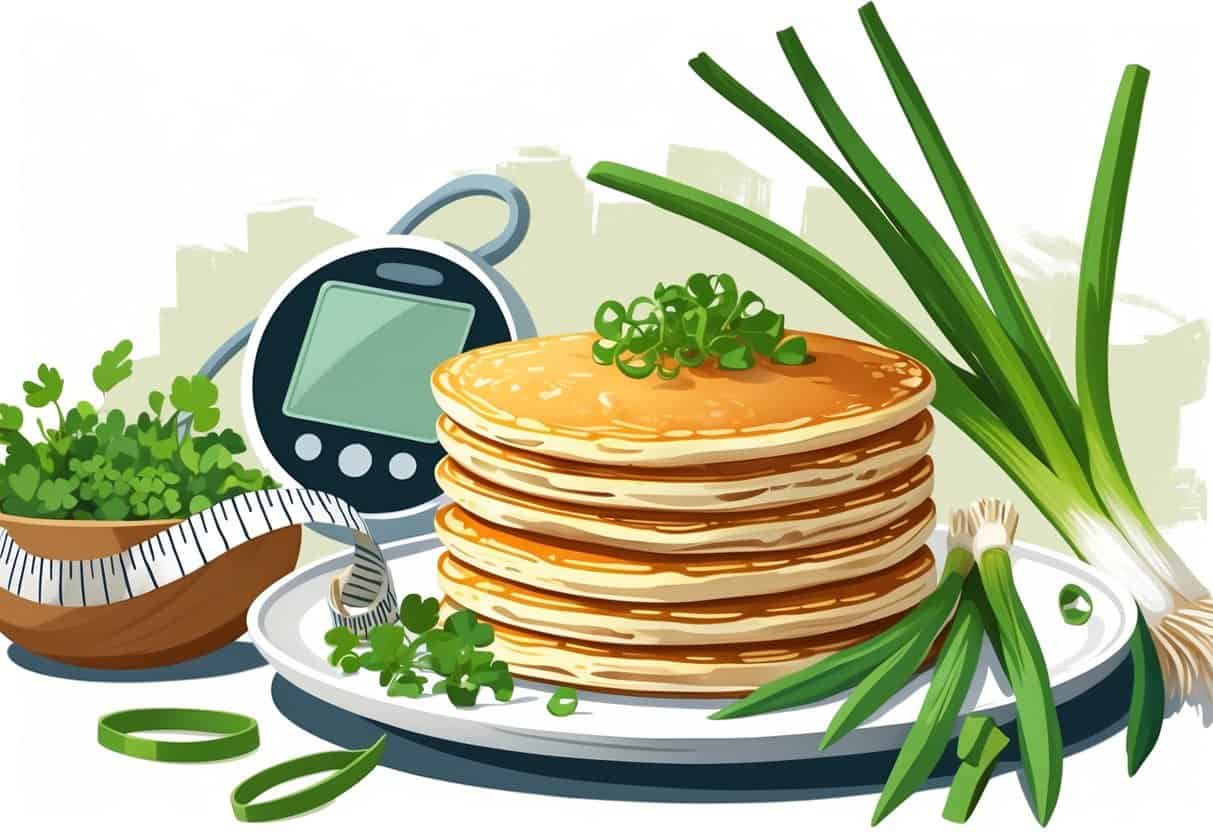Spring onion pancakes are a popular snack you might enjoy. If you have diabetes, though, you might wonder if they’re actually safe to eat.
Because these pancakes are often fried and made with flour, they can raise blood sugar levels quickly. That makes them a less ideal option for people with diabetes.

Not all spring onion pancakes are created equal. Some recipes use less batter or swap in alternative ingredients to cut carbs and fats.
Understanding how these pancakes affect your blood sugar can help you decide if and how you can include them in your diet. It’s worth looking at what goes into them and how they’re made.
Key Takeaways
- Spring onion pancakes can cause a quick rise in blood sugar.
- Ingredient choices really matter for your health.
- Knowing how they fit into your diet helps you make safer decisions.
Nutritional Profile of Spring Onion Pancakes
Spring onion pancakes have a mix of carbohydrates, fats, and proteins. The main ingredients shape their nutrition.
They provide some vitamins and minerals from the spring onions. Fiber content is usually pretty low, though.
Carbohydrate Content and Glycemic Index
A serving of spring onion pancakes contains about 43 grams of carbohydrates, mostly from wheat flour. That’s a lot if you’re watching your blood sugar.
The glycemic index (GI) depends on the type of flour used. White wheat flour, which is common, has a moderate to high GI.
That means it can cause your blood sugar to spike more quickly. If you’re diabetic, limiting how often you eat these pancakes—or choosing whole grain flour—could help.
Pairing pancakes with protein or fiber might slow glucose absorption a bit.
Key Ingredients and Macronutrient Breakdown
The main ingredients are white wheat flour, water, oil, and spring onions.
In a typical serving, you get:
- Calories: 256
- Carbohydrates: 43 g
- Fat: 9.4 g
- Protein: 7 g
Most of the fat comes from the oil used in cooking. That adds to the calorie count.
The protein content is modest. It helps balance the meal a little, but not much.
The type and amount of oil matter. Too much oil can bump up the fat content quickly.
Fiber, Vitamins, and Minerals
Spring onions add fiber, vitamins, and minerals to the pancakes. Still, total fiber stays low because of the refined flour.
Spring onions bring in nutrients like:
- Vitamins A, C, K, B6, and B9
- Minerals: calcium, iron, potassium, magnesium, and zinc
These nutrients are good for overall health, but they don’t do much for blood sugar control.
If you want more fiber, try adding whole grain flour or extra veggies. That can help with blood sugar and digestion.
Impact of Spring Onion Pancakes on Blood Sugar
Spring onions themselves don’t really affect blood sugar much. The bigger concern is the flour and how the pancakes are made.
How Spring Onion Pancakes Affect Glucose Levels
Spring onions have a low glycemic index, so they’re not the problem. But the pancakes use white wheat flour, which has a higher GI.
That means your blood sugar can rise after eating them. The oil adds calories but doesn’t impact blood sugar directly.
If you eat them in moderation, and balance your meal with protein or fiber, the impact might be manageable.
Potential Glycemic Load per Serving
A typical pancake has about 1/4 cup of white flour. White flour has a high glycemic load, so it can spike your blood sugar.
To lower the glycemic load, you could eat smaller portions or try recipes with whole grain flour. Adding vegetables or protein on the side helps slow the rise in blood glucose.
| Ingredient | Effect on Blood Sugar | Notes |
|---|---|---|
| Spring onions | Very low impact (GI 10-15) | Safe for blood sugar control |
| White flour | High glycemic load | Raises blood sugar levels |
| Cooking oil | No direct effect | Adds calories, no sugar impact |
Considerations for Diabetics Consuming Spring Onion Pancakes
When you eat spring onion pancakes, you need to pay attention to portion size and frequency. Recipe tweaks can help lower their impact on your blood sugar.
Combining the pancakes with low-carb, low-sugar foods can also help keep things steady.
Portion Control and Serving Frequency
Keeping portions small is key. These pancakes contain enough carbs to raise your blood glucose.
Try to stick to one small pancake or half of a regular one per serving. Eating pancakes only occasionally lowers your risk of blood sugar spikes.
Track your carb intake over the day and factor in the pancakes. Measuring tools like kitchen scales or cups can help with portion sizes.
Eat slowly and stop when you feel full—easier said than done, but it helps.
Suitable Recipe Modifications
You can make changes to the recipe to help your blood sugar. Use whole grain or low-carb flours instead of white flour.
Almond flour or oat flour are worth a try. Skip added sugars or high-carb ingredients.
Avoid syrup or sweet sauces—tempting, but not great for blood sugar. Use more spring onions, spices, or a little healthy fat like olive oil for flavor.
Cooking in healthier oils instead of butter or margarine makes a difference. Thinner dough means less carbs per pancake, too.
Pairing with Other Diabetic-Friendly Foods
Pair your pancakes with foods that won’t spike your blood sugar. High-fiber veggies like spinach or kale are smart picks.
They add some bulk and nutrients but not a lot of carbs. That’s a win if you ask me.
Protein and healthy fats can help slow down sugar absorption. Maybe toss in a side of eggs, a bit of cheese, or some avocado.
That combo helps balance things out and keeps your blood sugar steadier. It’s honestly a better way to enjoy pancakes if you’re watching your numbers.
Skip the sugary drinks or fruit juices. Water, unsweetened tea, or coffee are better bets.